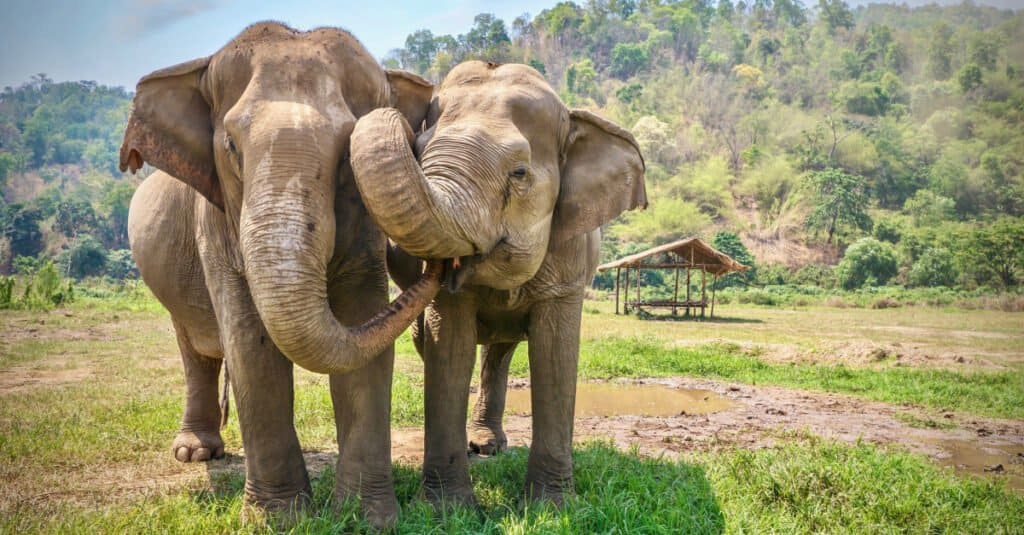Elephants are intelligent creatures that have been known to express a wide range of emotions, from excitement and shyness to rage and grief. These giants are herd-oriented and always on the lookout to protect members of their unit.
As a result of their heavy build, it’s easy to attribute aggression and hostility to elephants. However, like any other creature, elephants get upset and, when in danger, defend themselves with the tools evolution gave to them.
So, are elephants aggressive or just misunderstood? Here’s all you need to know about elephant temperaments and behaviors.
Is an Elephant an Aggressive Animal?

Although elephants are naturally peaceful animals, under certain circumstances, they may get get violent.
©AndyElliott/Shutterstock.com
Elephants are naturally peaceful creatures, but they may get violent under certain circumstances. For instance, mother elephants may aggressively defend their young when they are threatened. Furthermore, when asserting their dominance, male elephants can be hostile. Simply put, male or female elephants can become hostile when they are harmed, ill, or mistreated.
You should also note that male elephants experience musth, and are especially aggressive during this period. During musth, a bull is motivated by an increase in reproductive hormones, especially testosterone, which causes rage fits and more aggressive tendencies that are less likely to be displayed by bulls out of musth.
There are several ways that elephants may respond to challenges or threats. Examples include making noise and fussing to demonstrate their dominance. Male elephants will also often mock-charge to show their strength. They will spread their ears and flap while looking directly at the threat. Other defensive behaviors include upset trunk movements, swinging of feet, avoiding threats, and breaking off branches.
How Aggressive Are Elephants in Musth?
A male elephant in musth is the most hazardous kind. Musth is a normal periodic condition in bulls, and is characterized by elevated testosterone, temporal drainage, and dribbling/trickling of urine. Elephants can become aggressive during musth, and difficult to control by people they would normally be friendly towards.
When living in captivity, it is not unusual for a male elephant in musth to kill keepers and carers, just as it is not unusual for their wild counterparts to attack humans at this time. The slightest disruption or human presence is perceived as a challenge to be overcome by bull elephants during musth, yet many of these same elephants would not be troubled by the same disturbance when not in musth.
It’s crucial to note that because Asian elephants’ musth is widely known, many people mistakenly believe that African bush elephants do not go through it. However, evidence demonstrates that African elephants also experience musth.
Which Elephants Are More Aggressive?

Female elephants may get extremely aggressive when protecting their young.
©CherylRamalho/Shutterstock.com
A mother elephant protecting her child is perhaps the most aggressive elephant you will meet. It is a well-known fact that most mothers, regardless of species, would defend their offspring with ferocity and violence if necessary. Elephants are the same. A mother elephant would babysit and nurture her calf for hours or even days if it is hurt or frail before moving on. Whether it’s a mother elephant, bear, or goat, it’s never a good idea to interfere with a mother and her child.
Are Elephants Aggressive Toward Humans?
Elephants are not always aggressive to people, but certain situations may make elephants quite hostile to people. For instance, it’s not uncommon for female elephants to become violent after giving birth, and male elephants may be aggressive during musth.
Many elephants kept in cruel captivity are also capable of acting violently toward people. This can occasionally be brought on by trauma, annoyance, or boredom in an uninteresting setting.
That stated, there is little to no risk involved with watching a typical herd of wild elephants while on a safari. Observing these magnificent animals can be a once-in-a-lifetime experience since knowledgeable field guides maintain a safe distance and take safety procedures to ensure that the elephants do not feel threatened by humans. Although, caution must be observed to avoid elephant stampedes.
It is also interesting to note that elephants protect one another because they value their families and are highly intelligent. Therefore, any herd member at risk due to illness, size, or age will be protected.
How to Recognise Aggressive Elephants
Elephants usually don’t act aggressively except they feel threatened. Therefore, one of the best ways to recognize aggressive elephants is to recognize their body language when they feel threatened or challenged. Elephants respond to challenges or threats in a variety of ways. Male elephants frequently mock-charge to demonstrate their strength. They charge at humans to show their strength and authority, although their charges can occasionally be just a run-on. In most cases, mock charges are stopped before they reach their target. However, if an elephant keeps charging, it can easily kill a person.
Furthermore, female elephants spread their ears and begin flapping while looking directly at the threat. They may also raise their head and trunk to warn foes that they are dangerous. Other defensive behaviors of elephants include upset trunk movements, swinging their foot, and breaking off branches.
As a rule, it is best not to inflict pain on elephants since this may provoke them to charge. Furthermore, regarding female elephants, it’s critical to respect female elephants’ privacy and avoid endangering them or their calf, as mother elephants may act aggressively to defend their young.
Up Next:
- Stampeding Elephants Remind Tourists Why You Stay In Your Car on Safari
- 12 of the Oldest Elephants Ever Recorded
- How Smart Are Elephants? Their Intelligence Explained
- Are Elephants Ungulates?
The photo featured at the top of this post is © JohnEGoodwin/Shutterstock.com
Sources
- W.R. Langbauer Jr, Available here: https://onlinelibrary.wiley.com/doi/abs/10.1002/1098-2361(2000)19:5%3C425::AID-ZOO11%3E3.0.CO;2-A
- Joyce H. Poole, Available here: https://www.sciencedirect.com/science/article/pii/0003347289900146
- Joyce H. Poole & Cynthia J. Moss , Available here: https://www.nature.com/articles/292830a0.pdf#citeas
- Byrne, Richard; Lee, P.C.; Njiraini, N.; Poole, J.H.; Sayialel, K.; Sayialel, S.; Bates, L.A.; Moss, C.J., Available here: https://www.ingentaconnect.com/content/imp/jcs/2008/00000015/f0020010/art00008
Thank you for reading! Have some feedback for us? Contact the AZ Animals editorial team.






